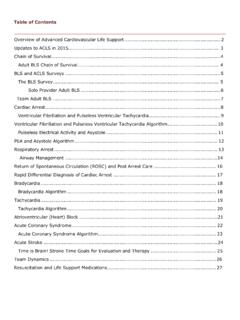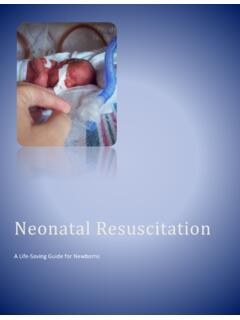Transcription of ADULT CPR with AED - nationalcprassociation.com
1 ADULT CPR with AED FOLLOWS 2010 ECC/ILCOR GUIDELINES Updated with 2015 Guidelines Welcome! We re excited that you ve decided to take CPR, and that you ve chosen us to direct your learning experience. Despite technological advances and new scientific discoveries, heart disease remains the number one cause of death globally, with million deaths per year; of cases of out of hospital cardiac arrests (OHCA) are witnessed by a bystander (AHA, 2015). Learning CPR can save lives- you can save a life. In this course, you will learn: The Chain of Survival and your place within the chain How to provide high quality chest compressions for adults How to initiate early use of an AED (automated external defibrillator) How to provide rescue breathing for victims of respiratory arrest How to provide CPR with 2 rescuers How to assist ADULT victims of choking Let s get started! The Five Fears Many bystanders are reluctant to perform CPR. There are many reasons why bystanders are reluctant to get involved.
2 Let s take a look at some of these reasons so that you can understand why they have no real basis of support. Fear of Disease: Use universal precautions when the possibility exists of coming into contact with bodily fluids. Use gloves, mask, and/or gown when you have them available. The benefit of initiating lifesaving resuscitation in a patient in cardiopulmonary arrest greatly outweighs the risk for secondary infection in the rescuer or the patient. Nevertheless, use of simple infection-control measures during CPR and CPR training can reduce a very low level of risk even further (Mejicano & Maki, 1998). Fear of Lawsuits: These laws state that a person acting in good faith who is rendering reasonable first aid will not be held accountable for damages to the person to whom the aid is rendered, unless gross and willful misconduct are involved. Good Samaritan laws may differ for professional health care providers versus lay rescuers from state to state. Implied consent means that there is an assumption that if an unconscious person were able to request care, they would do so.
3 Fear of Uncertainty: People sometimes fear that they won t remember what to do. Remembering the correct number of compressions or the number of compressions to ventilations is not as important as the willingness to respond and to push hard and fast. Hands-only CPR is designed to provide simple life support. No mask, no worry- performing compressions alone has been shown to be effective at saving lives. Fear of Harming the Victim: A victim in need or clinically dead can only be helped by your intervention efforts. You can t hurt someone who is dead, and any injuries you may unknowingly cause (such as injured ribs) can be dealt with in a surviving victim of cardiac arrest. Fear of Injury to Self: As you will learn, scene safety is of utmost importance, and checking the scene for safety should be your first action when you come across an unconscious victim. If the scene is not safe for you to enter, you must not enter. This will only result in more victims. Under no circumstances should you risk becoming a victim.
4 Instead, you should call for help (activate EMS). BASIC ANATOMY AND PHYSIOLOGY Before you learn how to perform CPR, it s important to understand how the heart, lungs, brain and cells perform. Here is a brief review of these systems. THE HEART The heart consists of four chambers, the right and left atria (singular: atrium) and the right and left ventricles. The atria are located above the ventricles, as can be seen in the above diagram. The heart is a muscular organ supplied by the coronary arteries. It is located below your breastbone (sternum) and, in an ADULT , is approximately the size of your fist. The heart pumps blood that has been deoxygenated after supplying the body s tissues into the lungs, and when that blood has been oxygenated again in the lungs, it exits the lungs to the left side of the heart, where it is pumped out into the body once again, to provide oxygen to the vital organs. Your body has about 5 liters of blood, which circulate through this system approximately 3 times per minute.
5 What is known as the cardiovascular system is composed of the heart, arteries, capillaries, and veins. THE LUNGS Your lungs are spongy, air-filled sacs, with one lung located on either side of the chest. The trachea, which is sometimes called the windpipe, conducts air down into the lungs through the bronchi, which are smaller tubular branches. The bronchi then divide into smaller and smaller tubules called bronchioles. Air is exchanged in the alveoli, which are tiny sacs that allow oxygen and carbon dioxide to move between the lungs and the bloodstream via tiny capillaries. Your lungs take in oxygen to supply your body s organs and tissues. They release carbon dioxide, a waste product, into the atmosphere when you exhale. Room air at regular atmospheric pressure contains 21% oxygen. Our bodies utilize approximately 4-6% of that oxygen and release about 16-17% back into the atmosphere, along with carbon dioxide, when we exhale. This 16-17% that we exhale can provide just enough oxygen to sustain someone in cardiac arrest, at least for a short time.
6 THE BRAIN Your brain needs a constant supply of oxygen. Without oxygen, brain cells begin to die in 4 to 6 minutes. On average, the brain weighs three pounds, and uses a whopping 20% of the body s oxygen! The medulla is located in the brain stem and controls automatic bodily functions, including consciousness and respiratory and cardiovascular function. THE BODY S CELLS All of the body s tissues are made up of cells. All cells require oxygen to carry out their normal functions. They also require nutrients. Oxygen deprivation, or hypoxia, will cause cells to die within a few short minutes. The body s cells use oxygen and produce carbon dioxide as a waste product. Carbon dioxide must be eliminated via the lungs through ventilation. Red blood cells transport oxygen throughout the body. CARDIOVASCULAR DISEASE As mentioned previously, cardiovascular disease is the number one cause of death worldwide. While it is important to learn what to do when cardiovascular disease leads to a heart attack or stroke, it is equally as important, if not more so, to understand how to prevent cardiovascular disease from occurring in the first place.
7 There are numerous factors that can increase an individual s risk of heart attack. Some of these factors can be controlled (modifiable risk factors), while others cannot (non-modifiable risk factors. Modifiable risk factors, or factors that can be controlled to a certain degree by an individual, include: cigarette smoking hypertension obesity sedentary lifestyle (lack of exercise) high cholesterol high blood sugar (in diabetes) poor diet (diet high in sugar, fat) stress Non-modifiable risk factors, or risk factors that individuals cannot change, include: age sex genetics/hereditary factors ( hereditary high cholesterol or hyperlipidemia) race ( , certain groups may be at higher risk for hypertension, or high blood pressure) CARDIOVASCULAR DISEASE IS THE NUMBER ONE CAUSE OF DEATH IN THE UNITED STATES, ACCORDING TO THE CENTER FOR DISEASE CONTROL (CDC). THE CDC ESTIMATES THAT MORE THAN 650,000 AMERICANS DIE FROM CARDIOVASCULAR DISEASE (1 in 4 DEATHS) EACH YEAR IN THE UNITED STATES.)
8 Cardiovascular disease damages the heart and blood vessels, and frequently causes heart attack and/or stroke. Americans of all ages should focus on prevention of cardiovascular disease by eating healthy foods, exercising 30 minutes (at least) each day, controlling weight, minimizing stress, consuming healthy fats and oils, and avoiding cigarette or cigar smoking. Atherosclerosis, or hardening of the arteries, is a condition caused by the building up of plaque inside the body s arteries, the large blood vessels that carry blood away from the heart to the body s organs. Plaque is composed of fatty substances, cholesterol, fibrin (a clotting substance in the blood), calcium and cellular waste products. When plaque builds up, it can partially or totally block the flow of blood through an artery in the brain (which causes stroke), the heart (which causes a heart attack), the kidneys, the arms, the legs and other vital areas. Plaque may break off to block an artery, or a blood clot (thrombus) may form on the surface of the plaque- either of these two circumstances can lead to a heart attack or stroke.
9 HEART ATTACK A heart attack often presents with one or more of the following symptoms: Chest tightness, pressure, or discomfort Nausea Sweating Shortness of breath Fatigue Weakness Pain in the jaw or arm Pallor (pale color of the skin) Women and people with diabetes often present with atypical symptoms, such as nausea and vomiting or back pain. About one-third of patients report no chest pain at all. WHAT CAN YOU DO? Recognize the symptoms and signs of a heart attack. Call 911. Don t let the patient drive him or herself to the hospital Keep the patient calm and seated in a position that is comfortable. Offer 1 ADULT aspirin or 2 baby aspirin- aspirin should be chewed before swallowing to speed absorption (Note: do not give if the patient has already taken aspirin or if the patient has an allergy to aspirin) Be prepared to start CPR if it becomes necessary STROKE You should suspect stroke if a patient or victim presents with: Severe headache with no known cause Numbness or weakness of the face, arm or leg on one side of the body Drooping eyelid or mouth on one side Confusion or trouble understanding Difficulty speaking (slurred speech or difficulty finding words) Loss of balance or coordination Dizziness Trouble with vision ( blurred or double vision, loss of vision in one eye) WHAT CAN YOU DO?
10 Know the signs and symptoms of a stroke Call 911 Don t give the patient food or drink Keep the patient calm and quiet Monitor the patient Be prepared to begin CPR if it becomes necessary A stroke is caused by one of two mechanisms: it can be caused by a ruptured blood vessel in the brain (called a hemorrhagic stroke) or by a blockage in one of the arteries that causes loss of blood flow and oxygen to a part of the brain (called an ischemic stroke). Ischemic strokes are more common. Remember that Time is brain, and act quickly. Stroke is the 3rd leading cause of death in the United States. Guideline Changes For anyone who has taken CPR prior to 2010, there have been a few key changes since the 2010 Guidelines were instituted. These changes include: Changing from the ABCs (Airway-Breathing-Circulation) to a C-A-B sequence of steps. This was one of the major changes that took place in 2010, when research showed that decreasing the delay in beginning chest compressions lead to a higher incidence of ROSC (return of spontaneous circulation).



